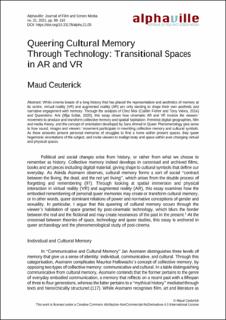Queering Cultural Memory Through Technology: Transitional Spaces in AR and VR
Journal article, Peer reviewed
Published version

Åpne
Permanent lenke
https://hdl.handle.net/11250/3020594Utgivelsesdato
2021Metadata
Vis full innførselSamlinger
Originalversjon
Alphaville: Journal of Film and Screen Media. 2021, 21, 89-110. 10.33178/alpha.21.05Sammendrag
While cinema boasts of a long history that has placed the representation and aesthetics of memory at its centre, virtual reality (VR) and augmented reality (AR) are only starting to shape their own aesthetic and narrative engagement with memory. Through the analysis of Chez Moi (Caitlin Fisher and Tony Vieira, 2014) and Queerskins: Ark (Illja Szilak, 2020), this essay shows how cinematic AR and VR involve the viewers’ movement to produce and transform collective memory and spatial habitation. Feminist digital geographies, film and media theory, and the concept of orientation developed by Sara Ahmed in Queer Phenomenology give sense to how sound, images and viewers’ movement participate in rewriting collective memory and cultural symbols. As these artworks present personal memories of struggles to find a home within present spaces, they queer hegemonic orientations of the subject, and invite viewers to realign body and space within ever-changing virtual and physical spaces.
